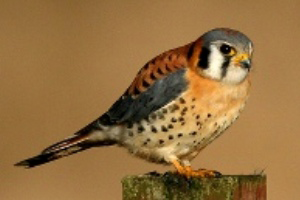American kestrels nest in cavities. Declines in the availability of natural cavities have caused declines in populations, but properly installed nest boxes can offset these losses and contribute to population increases, provided suitable foraging habitat exists.
Photo Credit: Blake Matheson
Falco sparverius
Common Name: American kestrel
Other Common Names: sparrow hawk
Animal Guild: Bird
Class > Order > Family: Aves > Falconiformes > Falconidae
What does the species look like?
The American kestrel is the smallest, most numerous and widespread of North American birds of prey. The kestrel is largely rufous to reddish with a stripe down from the eye and another past the ear. Males have distinctive bluish wings. It is quite different from any other bird usually seen in its habitat. It hunts from a perch or in flight, often hovering.
Where is the species found?
States & Provinces
AB, AK, AL, AR, AZ, BC, CA, CO, CT, DC, DE, FL, GA, IA, ID, IL, IN, KS, KY, LA, MA, MB, MD, ME, MI, MN, MO, MS, MT, NB, NC, ND, NE, NH, NJ, NL, NM, NS, NT, NV, NY, OH, OK, ON, OR, PA, PE, QC, RI, SC, SD, SK, TN, TX, UT, VA, VT, WA, WI, WV, YT
Distribution
The American kestrel breeds south of the tundra from Alaska and Canada south through the lower 48 states, Mexico, Central America, and much of South America. It winters in most of this range except for the northern Great Plains, Canada and Alaska.
American kestrels use a wide range of open habitats, including open woodland and forest edge, suburban parks, agricultural land, and riparian areas. They nest in cavities of large trees, crevices among rocks and human-made structures, and in nest boxes. Populations may be limited the availability of large trees with suitable cavities in many parts of the breeding range.
General Phenology and Life History
In areas where kestrels do not overwinter, they return in late winter or early spring. Egg-laying begins in March in the south and as late as June in the north. In the south, a pair may produce two broods, but second broods in the north are the result of a failed nest. The time from egg-laying to fledging is about 60 days. Fledged young are dependent on parents for another two weeks or a little more. Siblings often spend the summer together.
Which phenophases should I observe?
Do you see/hear...?
Activity
Live individuals More...
For abundance, enter the number of individual animals observed in this phenophase.
Feeding For abundance, enter the number of individual animals observed in this phenophase.
Calls or song For abundance, enter the number of individual animals observed in this phenophase.
Territorial individuals For abundance, enter the number of individual animals observed in this phenophase.
Reproduction
Courtship For abundance, enter the number of individual animals observed in this phenophase.
Mating For abundance, enter the number of individual animals observed in this phenophase.
Nest building For abundance, enter the number of individual animals observed in this phenophase.
Occupied nest For abundance, enter the number of individual animals observed in this phenophase.
Development
Nestlings For abundance, enter the number of individual animals observed in this phenophase.
Fledged young For abundance, enter the number of individual animals observed in this phenophase.
Dead individuals For abundance, enter the number of individual animals observed in this phenophase.
Dead nestlings or fledglings For abundance, enter the number of individual animals observed in this phenophase.
Method
Individuals at a feeding station For abundance, enter the number of individual animals observed in this phenophase.
What do these phenophases look like?
There is currently no photoguide available for this species. If you'd like help us create one, use the guidance document and species template provided here . Then send it via email to education@usanpn.org when it is complete.
